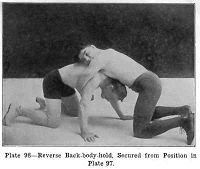
Back مصارعة الإمساك Arabic Catch Wrestling German Κατς Greek Catch wrestling Spanish کشتی کچ Persian Koukkupaini Finnish Catch wrestling French Catch wrestling Italian キャッチ・アズ・キャッチ・キャン Japanese 캐치 레슬링 Korean
 | |
| Also known as | Catch-as-catch-can (CACC) Lancashire wrestling Loose-hold Hooking Shoot wrestling |
|---|---|
| Focus | Wrestling, Grappling |
| Country of origin | United Kingdom |
| Famous practitioners | (see notable practitioners) |
| Parenthood | English wrestling (Cumberland, Westmorland, Cornish, Devonshire, Lancashire) Irish collar-and-elbow |
| Descendant arts | Freestyle wrestling, professional wrestling, shoot wrestling, folkstyle wrestling, Luta Livre, Sambo, mixed martial arts (MMA), Rough and tumble |
| Olympic sport | Yes (as amateur freestyle wrestling) since 1904 |
Catch wrestling (originally catch-as-catch-can) is a classical hybrid grappling style and combat sport. It was popularised by wrestlers of travelling funfairs who developed their own submission holds, or "hooks", into their wrestling to increase their effectiveness against their opponents. Catch wrestling derives from various different international styles of wrestling including several English styles (primarily Lancashire,[1] as well as Cumberland and Westmorland wrestling,[2] Devonshire,[2] Cornish wrestling and Irish collar-and-elbow wrestling). The training of some modern submission wrestlers, professional wrestlers and mixed martial artists is founded in catch wrestling.
Professional wrestling, once a legitimate combat sport, was competitive catch wrestling. The original and historic World Heavyweight Wrestling Championship was created in 1905 to identify the best catch-as-catch-can wrestler in the world, before the belt was retired in 1957 and unified with the NWA World Heavyweight Championship. Modern day professional wrestling has its origins in catch wrestling exhibitions at carnivals where predetermined ("worked") matches had elements of performing arts introduced (as well as striking and acrobatic manoeuvres), turning it into an entertainment spectacle.[3] In a few countries, such as in France and Germany, "Catch" is still the term used for professional wrestling.[4]
Catch-as-catch-can was included in the 1904 Olympic Games; it had new rules and weight categories introduced similar to other amateur wrestling styles, and dangerous moves — including all submission holds — were banned. New rules and regulations were later developed and codified by FILA and amateur catch wrestling became known as freestyle wrestling, which was then considered separate from the dangerous, professional catch style.[5][6]
Other martial arts with origins in catch wrestling include folkstyle wrestling, Sambo, Luta Livre, shoot-style, shootfighting and mixed martial arts (MMA).[citation needed][7]
- ^ "Submission Wrestling". aspullolympicwrestlingclub.co.uk. Archived from the original on 7 April 2005. Retrieved 19 November 2019.
- ^ a b Armstrong, Walter (1890), Wrestling
- ^ Slack, Jack (4 February 2016). "Kayfabe Time Capsule: The Real Techniques of Professional Wrestling". Fightland. Archived from the original on 8 November 2020. Retrieved 31 October 2019.
- ^ "Catch : l'histoire d'un sport spectacle marié avec la télé du 09 mars 2013". France Inter (in French). 9 March 2013. Retrieved 25 February 2023.
- ^ International Federation of Associated Wrestling Styles. "Freestyle Wrestling". FILA. Archived from the original on 11 July 2011. Retrieved 28 October 2008.
- ^ Nash, John S. (13 August 2012). "The Olympic History of Catch Wrestling". Bloody Elbow. Retrieved 5 November 2021.
- ^ Nauright, John; Zipp, Sarah (2020). Routledge Handbook of Global Sport. Routledge. p. 179. ISBN 978-1-317-50047-6.
© MMXXIII Rich X Search. We shall prevail. All rights reserved. Rich X Search